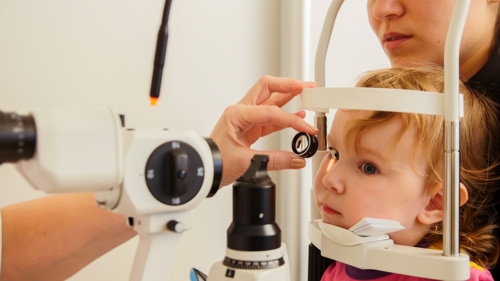Paediatric Ophthalmology
Paediatric Cataract Surgery Update
Complex cases challenge surgeons. Clare Quigley MD reports from Milan.

Clare Quigley
Published: Wednesday, November 9, 2022
Attendees at the paediatric cataract session of the World Society of Paediatric Ophthalmology and Strabismus meeting held in conjunction with the annual ESCRS Congress heard a series of presentations on particularly challenging cases.
Roberto Caputo MD opened with a discussion of the complex problem of paediatric cataract in uveitis. His approach to cataract in these cases is tailored to each patient.
“I ask myself three questions: first of all, who is the patient I am going to treat?” Dr Caputo said. “When can I do the surgery? And how can I do this surgery?”
He highlighted that cataract in Juvenile Idiopathic Arthritis (JIA) is particularly challenging, with a high risk of complications.
“Can we really wait three months without relapses to do surgery?” The three-month wait is a widespread approach to judging the safe time to wait until cataract surgery in a patient with uveitis, but Dr Caputo questioned whether this is always the best approach, especially in a child with a dense cataract.
Marta Morales MD, a paediatric ophthalmologist in Barcelona, Spain, also discussed timing decisions—though in infant cataract surgery. “It is not recommended to implant an IOL before seven months of age,” she said. “This is [particularly] due to the risk of visual axis opacification and subsequent requirement for surgery.”
“If we have a dense congenital cataract, we should operate as soon as possible, but it is better not to operate before four weeks of age,” Dr Morales said. “During this age, the anterior segment is still developing.” Performing surgery at this neonatal development stage can increase the risk of glaucoma.
Hannah Scanga, genetic counsellor in UPMC Pittsburgh, Pennsylvania, US, talked about genetics of paediatric cataract. “Your highest diagnostic rate will be found with bilateral cataracts,” Ms Scanga said. Determining a genetic cause starts with history and exam, so she suggested examining the parents as well.
Important findings in parents can help narrow down the search for a causal mutation—for example, in mothers who are carriers of Lowe syndrome, spoke-like lens changes may be observed.
“Genetic causes continue to be identified,” Ms Scanga said. “Customisation is helpful.” She recommended a multigene panel as an effective investigative tool.
Göran Darius Hildebrand MD, Oxford, UK, reiterated paediatric cataract surgery is a vital treatment and that problems arise in postponing surgery. “Delayed surgery leads to permanent brain damage in the form of amblyopia, strabismus, and nystagmus.”
Dr Hildebrand said the best formulae available for use in children are SRKT and Holladay 1, as evidenced by a recent meta-analysis.i But even the best available formulae do not yield results comparable to the accuracy of biometry in adults.
“The [rate of] absolute prediction error outside two dioptres reaches 50%.” This error rate is due to numerous factors specific to children, including technical issues obtaining biometry and variable childhood emmetropization.
Dr Hildebrand went on to discuss different approaches to reduce visual axis opacification in children, highlighting the utility of the bag-in-the-lens (BIL), invented by Prof Marie-José Tassignon. For surgeons without access to BIL, optic capture of a sulcus IOL optic through the anterior and the posterior capsule is a potential method to reduce risk of opacification of the visual axis.
i Zhong et al. Journal of Refractive Surgery. 2021.
Roberto Caputo MD is Director, Department of Ophthalmology, A Meyer Children’s Hospital, Florence, Italy. r.caputo@meyer.it
Marta Morales Ballús MD, SJD Barcelona Children’s Hospital, Barcelona, Spain.
Hannah Scanga, genetic counsellor in UPMC Pittsburgh, Pennsylvania, US.
G Darius Hildebrand FRCS, FRCOphth, FEBO is Head of Paediatric Ophthalmology and Strabismus, Oxford Eye Hospital, UK. darius.hildebrand@ouh.nhs.uk

Tags: 40th Congress of the ESCRS, Paediatric
Latest Articles
Towards a Unified IOL Classification
The new IOL functional classification needs a strong and unified effort from surgeons, societies, and industry.
Organising for Success
Professional and personal goals drive practice ownership and operational choices.
Update on Astigmatism Analysis
Is Frugal Innovation Possible in Ophthalmology?
Improving access through financially and environmentally sustainable innovation.
iNovation Innovators Den Boosts Eye Care Pioneers
New ideas and industry, colleague, and funding contacts among the benefits.
José Güell: Trends in Cornea Treatment
Endothelial damage, cellular treatments, human tissue, and infections are key concerns on the horizon.
Making IOLs a More Personal Choice
Surgeons may prefer some IOLs for their patients, but what about for themselves?
Need to Know: Higher-Order Aberrations and Polynomials
This first instalment in a tutorial series will discuss more on the measurement and clinical implications of HOAs.
Never Go In Blind
Novel ophthalmic block simulator promises higher rates of confidence and competence in trainees.